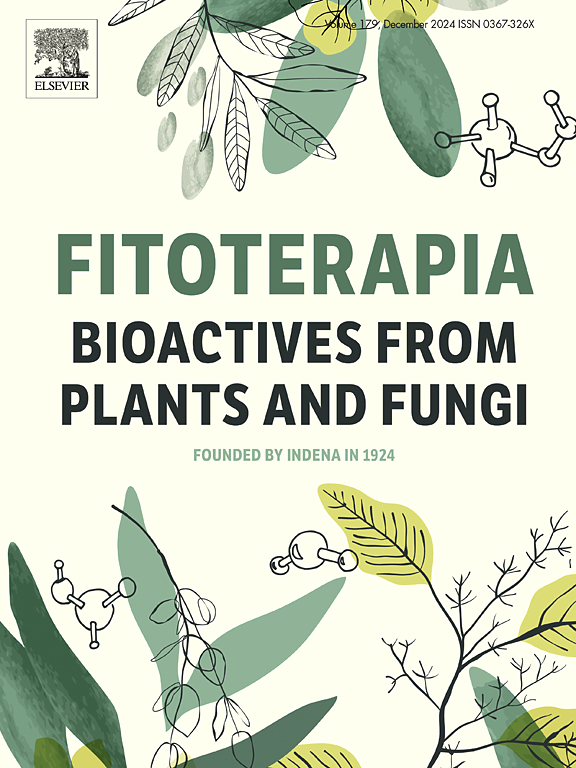基于斑马鱼模型、网络药理学和实验验证,探讨川芎治疗血栓形成的分子机理。
IF 2.6
3区 医学
Q3 CHEMISTRY, MEDICINAL
引用次数: 0
摘要
虎杖(Toddalia asiatica (L.) Lam.(TA)是中国西南少数民族的传统民间药材。它被广泛用于散瘀活血的治疗。然而,其有效物质和药理机制尚未完全阐明。本研究以斑马鱼幼体为研究对象,用苯肼(PHZ)处理斑马鱼幼体,建立血栓模型,分析斑马鱼红细胞的染色强度。首次验证了 TA 的抗血栓活性,发现 TA 对血栓形成的抑制率高达 60.85%。结合UPLC-HRMS分析和文献研究,收集了TA的化学成分。网络药理学发现,TA有6个关键靶点,包括TNF、AKT1、EGFR、PTGS2、PPARG和IFNG。结果表明,PI3K-Akt通路是核心信号通路。凝血因子 III(TF)在止血和血栓形成过程中发挥着重要作用,在 PPI 网络中排名靠前。此外,分子对接结果表明,活性成分与TF有很强的结合力,这表明TF可能是TA治疗血栓形成的关键靶点。体外实验表明,TA能抑制TNF-α诱导的TF在EA.hy926细胞中的高表达。此外,TA还能抑制PI3K-Akt通路中TNF-α激活的Akt、IκBα和P65蛋白的磷酸化表达。结果表明,TA具有抗血栓活性,通过PI3K-Akt-NF-κB信号通路抑制TF的表达,从而发挥抗血栓作用。本文章由计算机程序翻译,如有差异,请以英文原文为准。
Exploring the molecular mechanism of Toddalia asiatica (L.) lam on the treatment of thrombosis based on zebrafish models, network pharmacology and experimental verification
Toddalia asiatica (L.) Lam. (TA) is a traditional folk medicine of ethnic minorities in the southwest of China. It is widely used in the treatment of dispersing blood stasis and activating blood. However, the effective substance and pharmacological mechanism have not been fully elucidated. The zebrafish larvae were treated with Phenylhydrazine (PHZ) to establish a thrombus model, and the staining intensity of zebrafish red blood cells was analyzed. The antithrombotic activity of TA was verified for the first time, and it was found that the inhibition rate of TA on thrombosis was up to 60.85 %. The chemical ingredients of TA were collected by combining UPLC-HRMS analysis and the literature research. Network pharmacology revealed that six key targets were obtained, which including TNF, AKT1, EGFR, PTGS2, PPARG, and IFNG. It showed that the PI3K-Akt pathway was a core signaling pathway. Coagulation factor III(TF), playing an important role in the process of hemostasis and thrombosis, which ranks high in the PPI network. Moreover, the results of molecular docking showed that the active components had a strong binding force with TF, which indicated that TF might be the key target of TA in treating thrombosis. In vitro experiments showed that TA could inhibit TNF-α-induced high expression of TF in EA.hy926 cells. In addition, TA could inhibit TNF-α-activated expression of Akt, IκBα and P65 protein phosphorylation in PI3K-Akt pathway. The results showed that TA had antithrombotic activity and exerted an antithrombotic effect by inhibiting the expression of TF through the PI3K-Akt-NF-κB signaling pathway.
求助全文
通过发布文献求助,成功后即可免费获取论文全文。
去求助
来源期刊

Fitoterapia
医学-药学
CiteScore
5.80
自引率
2.90%
发文量
198
审稿时长
1.5 months
期刊介绍:
Fitoterapia is a Journal dedicated to medicinal plants and to bioactive natural products of plant origin. It publishes original contributions in seven major areas:
1. Characterization of active ingredients of medicinal plants
2. Development of standardization method for bioactive plant extracts and natural products
3. Identification of bioactivity in plant extracts
4. Identification of targets and mechanism of activity of plant extracts
5. Production and genomic characterization of medicinal plants biomass
6. Chemistry and biochemistry of bioactive natural products of plant origin
7. Critical reviews of the historical, clinical and legal status of medicinal plants, and accounts on topical issues.
 求助内容:
求助内容: 应助结果提醒方式:
应助结果提醒方式:


